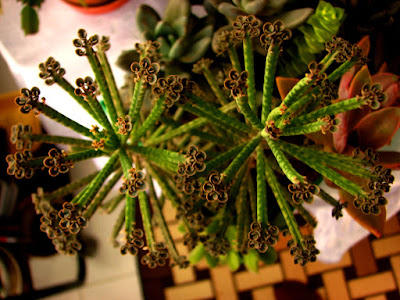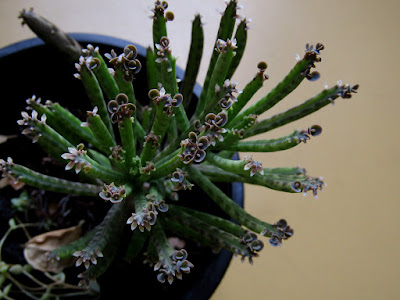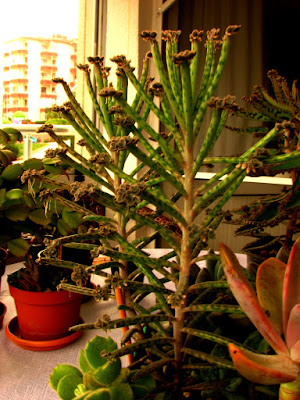Kalanchoe delagoensis - Chandelier plant is an erect, smooth, fleshy succulent plants whcih growing to 1 m or more in height with grey-brown leaves..
Kalanchoe delagoensis, also called as Chandelier plant, Mother of millions, Bryophyllum delagoense, Bryophyllum tubiflorum, Bryophyllum verticillatum, Geaya purpurea, Kalanchoe tubiflora, Kalanchoe verticillata, is a species of the genus Kalanchoe. This species was described by Christian Friedrich Ecklon & Karl Ludwig Philipp Zeyher in 1837.
IDENTIFY KALANCHOE DELAGOENSIS - CHANDELIER PLANT
Kalanchoe delagoensis is native to Madagascar. It is an aggressive weed with a high invasive potential. It is well adapted to water-stressed environments because of its succulent features. This species can be found growing at low elevations (0-1000 m) in pastures, grasslands, waste areas, roadsides and disturbed forests in dry, arid and semiarid habitats with warm temperatures. It is often found along stream banks and exposed rocks near water courses, as it can be spread by water.
It is an erect, smooth, fleshy succulent plants which growing to 1 m or more in height with grey-brown, fleshy, tubular-like leaves with up to seven projections at the tip of each leaf. This species blooms in winter from the tall flower spikes with clusters of bell-shaped flowers. The flowers are orange-red and occur in a cluster at the top of a single stem.
Chandelier plant reproduces by seed and by producing large numbers of tiny plantlets at the end of the fleshy leaves. Dislodged leaves and broken leaf parts can also take root and give rise to new plants. Seeds can germinate for some years after production.
According to the ASPCA and the pet poison helpline, these plants are considered toxic to pets. It contain cardiac toxins (bufadienolides). The level of toxicity is generally mild to moderate and rarely severe. When ingested by dogs and cats, the most common symptoms are gastrointestinal irritation or upset. If large amounts are ingested, there is a higher risk of more severe symptoms such as changes in heart rate and rhythm. When in doubt, do not leave this plant near pets.
KALANCHOE DELAGOENSIS - CHANDELIER PLANT CARE AND CULTURE
Cultural information should only be used as a guide, and should be to be adapted to suit you. Your physical location; where you grow your plants, how much time you have to devote to their care, and many other factors, will need to be taken into account. Only then can you decide on the cultural methods that best suit you and your plants.
Light:
Kalanchoe delagoensis can grow in full to partial sun, a southern, eastern or western exposure. During summer do not allow direct sunlight because its leaves who contain lots of water will get sun-burned. Direct sunlight from fall till early spring will not harm your plant.
Temperature:
Chandelier plant grow best at the optimum temperatures range between 64 and 68 °F (18 and 20 °C) day and night. If temperatures are under 61 °F (16 °C) day and night, this can delay plant growth and development and may cause blind eyes or no flowering. It is very sensitive to cold and it takes only a few hours of near 40 °F (4 °C) for the plant to die. Avoid placing it near drafts or cool windowsills.
Substrate and growing media:
Kalanchoe delagoensis can be grown in 2.5-inches, 4-inches or 6-inches pots with the rooting media and subsequent growing media that are fast draining and high in organic matter. Their root system is extremely sensitive and it would be advisable to use clay pots that allow better aeration of the roots. Ensure excellent drainage by placing pebbles at the bottom of the pot and use light soil containing lots of peat moss, perlite and sand.
The plants love to be alone in small pots. However, the larger the pot the larger the leaves but the size of the top will hardly affect blooming or rate of growth. Avoid planting companion plants in the same pot and repot each spring adding fresh soil.
The pH is also critical and should be in the 6.0 to 6.5 range. The plants are sensitive to zinc deficiency, which can be aggravated by high phosphorous. But at this pH range, both zinc and phosphorous should be available at suitable levels. They also have high calcium requirements.
Watering:
Chandelier plant like water only when the top level of their soil is dry. Wet soil should be avoided. The most common mistake people make is overwatering which can cause the roots to rot. You can easily prevent this by allowing your plant to dry out completely before watering. The foliage should be kept as dry as possible and, therefore, using a system, such as drip irrigation, is best.
Fertilizer:
Fertilize the plants with ratio 3:1:3 (N:P:K) until bud formation. During the flowering period, the ratio should change to 2:1:4 or 3:1:4. It may be necessary to make supplemental applications of major elements, including calcium and magnesium and trace elements, particularly iron and manganese.
Pruning:
Little or no pruning is necessary for many years. If needed, pruning should be done immediately after flowering. When pruning, simply pinch or clip them back where they attach to the stem. Pinch out dead flowers regularly to stimulate new flowers to form.
Many of the new cultivars have good basal branching, so no pinching is required, which was a very labor-intensive project necessary with the older cultivars. However, if a cultivar requires pinching to encourage branching, today the plants are normally treated with growth regulators.
Rest period:
When the flowers start to die back, cut them off and let the plant rest. After deadheading, you should reduce watering as the plant will need less water during this resting period. Soon you will notice new buds and your plant will bloom again. This change in blooming and resting cycles will go on throughout the year irrelevant to seasons.
Pests and diseases:
Kalanchoe delagoensis are resistant to disease and insects but if kept outdoors, could eventually be affected by aphids, scale, spider mites and nematodes. Common symptoms include apart from insects themselves on the crossing of the stems or the undersides of leaves, the presence of honeydew on leaves, creased faded leaves and webs, or leaves that look torn or bitten. Prefer non-toxic treatments because the plants are very sensitive to certain ingredients used largely in insecticides widely used. If you decide to buy a chemical insecticide do tell the nursery that you are planning to use it on a plant.
Propagation:
Chandelier plant propagates by dropping the little plantlets or baby plants that grow on the tips of the leaves. These little plantlets will root and grow wherever it lands (literally everywhere). Their seeds are also known to survive long after the plants are pulled out. The plants can also propagated by stem cuttings.
















COMMENTS